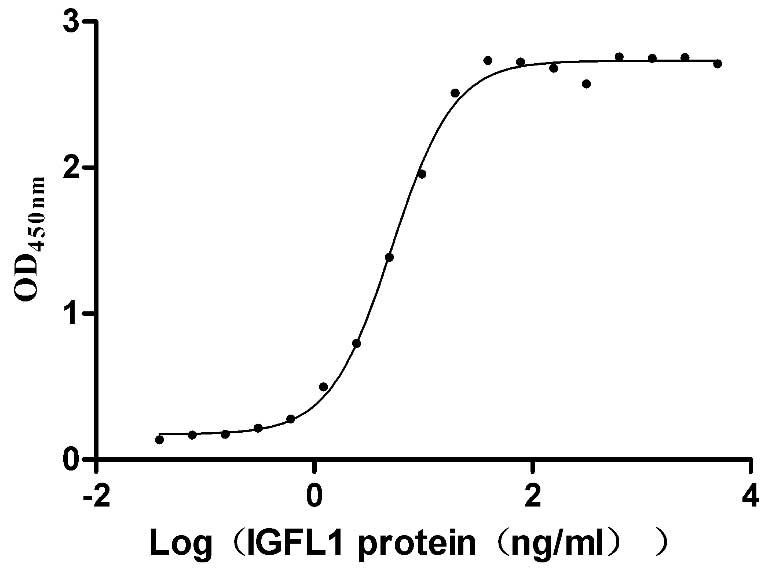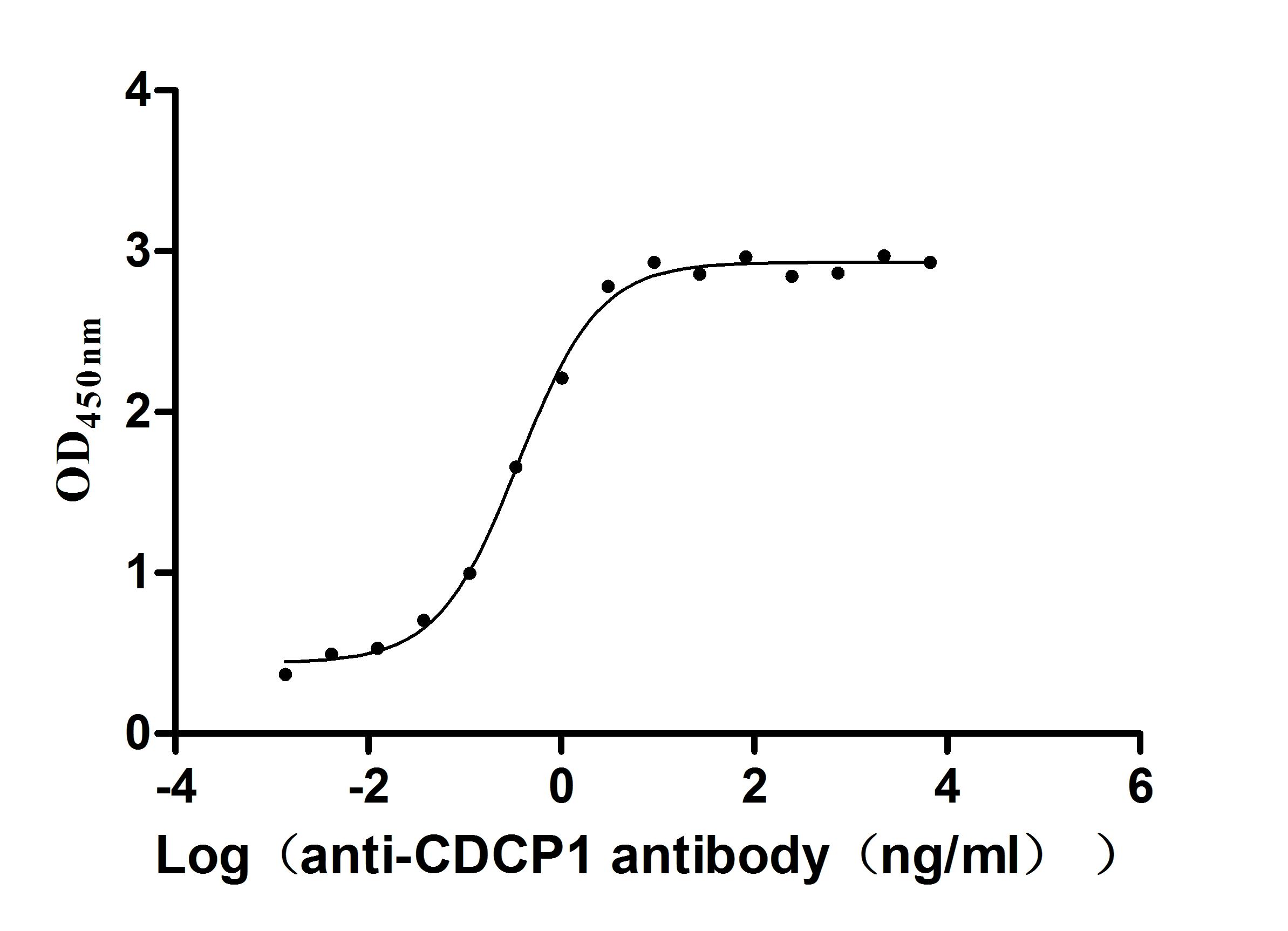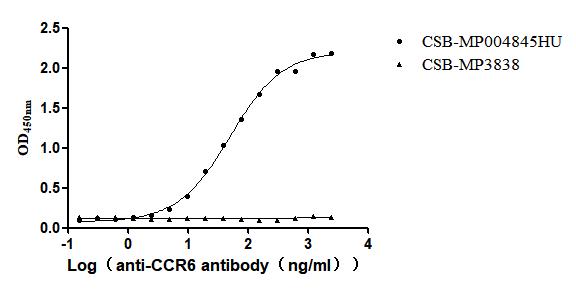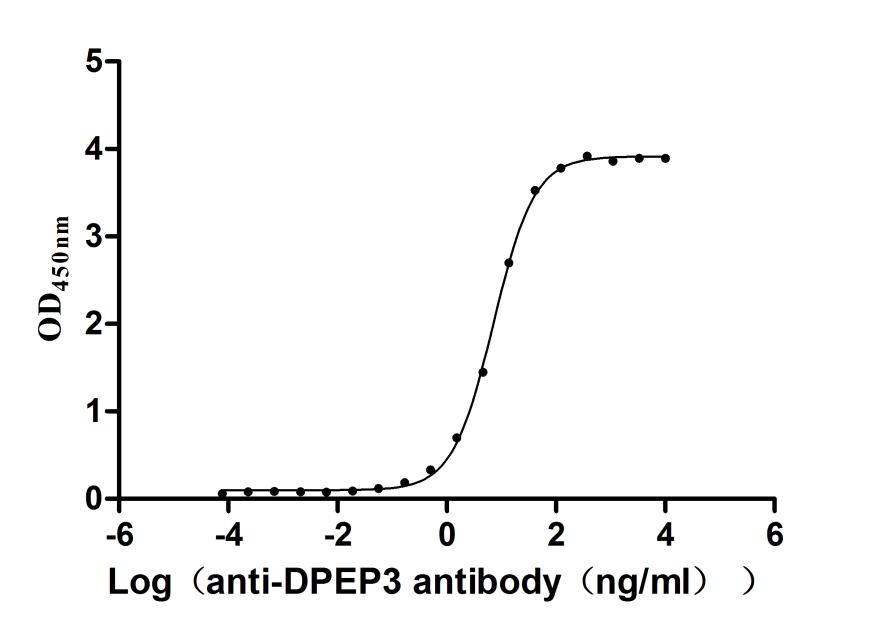Recombinant Human SH3 and multiple ankyrin repeat domains protein 3 (SHANK3), partial
-
中文名称:人SHANK3重组蛋白
-
货号:CSB-YP880134HU
-
规格:
-
来源:Yeast
-
其他:
-
中文名称:人SHANK3重组蛋白
-
货号:CSB-EP880134HU
-
规格:
-
来源:E.coli
-
其他:
-
中文名称:人SHANK3重组蛋白
-
货号:CSB-EP880134HU-B
-
规格:
-
来源:E.coli
-
共轭:Avi-tag Biotinylated
E. coli biotin ligase (BirA) is highly specific in covalently attaching biotin to the 15 amino acid AviTag peptide. This recombinant protein was biotinylated in vivo by AviTag-BirA technology, which method is BriA catalyzes amide linkage between the biotin and the specific lysine of the AviTag.
-
其他:
-
中文名称:人SHANK3重组蛋白
-
货号:CSB-BP880134HU
-
规格:
-
来源:Baculovirus
-
其他:
-
中文名称:人SHANK3重组蛋白
-
货号:CSB-MP880134HU
-
规格:
-
来源:Mammalian cell
-
其他:
产品详情
-
纯度:>85% (SDS-PAGE)
-
基因名:
-
Uniprot No.:
-
别名:AI841104; DEL22q13.3; KIAA1650; Proline rich synapse associated protein 2; Proline-rich synapse-associated protein 2; ProSAP2; PSAP2; SH3 and multiple ankyrin repeat domains 3; SH3 and multiple ankyrin repeat domains protein 3; SH3/ankyrin domain gene 3; SHAN3_HUMAN; Shank postsynaptic density protein; Shank3; Shank3b; SPANK 2; SPANK2
-
种属:Homo sapiens (Human)
-
蛋白长度:Partial
-
蛋白标签:Tag type will be determined during the manufacturing process.
The tag type will be determined during production process. If you have specified tag type, please tell us and we will develop the specified tag preferentially. -
产品提供形式:Lyophilized powder
Note: We will preferentially ship the format that we have in stock, however, if you have any special requirement for the format, please remark your requirement when placing the order, we will prepare according to your demand. -
复溶:We recommend that this vial be briefly centrifuged prior to opening to bring the contents to the bottom. Please reconstitute protein in deionized sterile water to a concentration of 0.1-1.0 mg/mL.We recommend to add 5-50% of glycerol (final concentration) and aliquot for long-term storage at -20℃/-80℃. Our default final concentration of glycerol is 50%. Customers could use it as reference.
-
储存条件:Store at -20°C/-80°C upon receipt, aliquoting is necessary for mutiple use. Avoid repeated freeze-thaw cycles.
-
保质期:The shelf life is related to many factors, storage state, buffer ingredients, storage temperature and the stability of the protein itself.
Generally, the shelf life of liquid form is 6 months at -20°C/-80°C. The shelf life of lyophilized form is 12 months at -20°C/-80°C. -
货期:Delivery time may differ from different purchasing way or location, please kindly consult your local distributors for specific delivery time.Note: All of our proteins are default shipped with normal blue ice packs, if you request to ship with dry ice, please communicate with us in advance and extra fees will be charged.
-
注意事项:Repeated freezing and thawing is not recommended. Store working aliquots at 4°C for up to one week.
-
Datasheet :Please contact us to get it.
靶点详情
-
功能:Major scaffold postsynaptic density protein which interacts with multiple proteins and complexes to orchestrate the dendritic spine and synapse formation, maturation and maintenance. Interconnects receptors of the postsynaptic membrane including NMDA-type and metabotropic glutamate receptors via complexes with GKAP/PSD-95 and HOMER, respectively, and the actin-based cytoskeleton. Plays a role in the structural and functional organization of the dendritic spine and synaptic junction through the interaction with Arp2/3 and WAVE1 complex as well as...显示更多
-
基因功能参考文献:
- SHANK3 haploinsufficiency due to point mutations alone is sufficient to cause a broad range of phenotypic features associated with Phelan-McDermid syndrome. PMID: 29719671
- Our report details a 10-year-old boy with a de novo heterozygous c.1231del, p.Arg411Val frameshift variant in SHANK3, a high-risk candidate autism gene. We report significant speech delay and seizures as an association with this phenotype. PMID: 29939863
- SHANK3 expression correlated with ZO-1 and PKCepsilon in colonic tissue of patients with Crohn's disease. The expression level of SHANK3 affects ZO-1 expression and the barrier function in intestinal epithelial cells. PMID: 28906292
- We report a family with four affected individuals including the 37 year-old mother, her 12 year-old male monozygotic twins and 8 year-old daughter harboring a novel SHANK3 interstitial microdeletion PMID: 28754298
- the present study did not provide evidences to support the fact that SHANK3 variants could influence the susceptibility to Autism spectrum disorder in the Northeastern Han Chinese population PMID: 29408620
- SHANK3 expression was increased in the neocortex of temporal lobe epilepsy patients and rats. PMID: 27592227
- Missense mutation in SHANK3 gene is associated with schizophrenia. PMID: 28371232
- This study does not provide evidence for a major role of SHANK3 in the pathogenesis of bipolar disorder. PMID: 27512916
- Partial knockdown of SHANK3 expression in human dorsal root ganglion neurons abrogates TRPV1 function. PMID: 27916453
- GWA study identified maternal genetic effects not previously identified in ASD at a locus in SHANK3. PMID: 27876814
- SHANK1 and SHANK3 act as integrin activation inhibitors by sequestering active Rap1 and R-Ras via the SPN domain and thus limiting their bioavailability at the plasma membrane. PMID: 28263956
- No specific EEG abnormality is present in epilepsy due to to SHANK3 loss-of-function mutations. PMID: 27554343
- Haploinsufficiency of SHANK3 is a predisposing factor in adults with catatonia. PMID: 27519580
- post-transcriptional regulation of SHANK3 expression by three microRNAs (miRNAs), miR-7, miR-34a, and miR-504, is reported. PMID: 26572867
- these data suggest that SHANK3 mutations predispose to autism, at least partially, by inducing an Ih channelopathy that may be amenable to pharmacological intervention. PMID: 26966193
- De novo SHANK3 mutation causes Rett syndrome-like phenotype in a female patient. PMID: 25931020
- miR-7 binds to 3-prime untranslated regions of SHANK3 mRNA and causes the alteration of neuronal morphology and function, potentially playing a crucial role in the pathophysiological process of schizophrenia PMID: 25882257
- a mutation in SHANK3 that underscores its relevance in Autism Spectrum Disorder. PMID: 25646853
- This study identified and confirmed SHANK3 protein changes within the postsynaptic density in schizophrenia PMID: 25048004
- because the deletions in our patients do not involve the SHANK3 gene, we posit the existence of a new contiguous gene syndrome proximal to the smallest terminal deletions in the 22q13 region. PMID: 24700646
- This study is the first to identify specific chromosome 22q13.2q13.32 genomic regions, in addition to the terminal 22q13.33 genomic region encompassing SHANK3, associated with key phenotypes in Phelan-McDermid syndrome. PMID: 24136618
- The ability to alter the epigenetic modification and expression of SHANK3 by environmental factors suggests that SHANK3 may be a valuable biomarker for dissecting the role of gene and environment interaction in the etiology of ASD. PMID: 24186872
- our results suggested that this commonly genetic variant in SHANK3 gene strikingly decreased the risk of ism spectrum disorder in China. PMID: 24398551
- This study demonistrated that the uncoupling of ProSAP2/Shank3 nuclear shuttling from synaptic activity may represent a molecular mechanism that contributes to the pathology of SCZ in patients with mutations in ProSAP2/Shank3. PMID: 24382453
- analysis of SHANK3 mutations associated wtih autism and their effect on ligand binding to the ankyrin repeat region PMID: 23897824
- findings indicate that SHANK3 overexpression causes a hyperkinetic neuropsychiatric disorder PMID: 24153177
- We show that Phelan-McDermid syndrome neurons have reduced SHANK3 expression and major defects in excitatory, but not inhibitory, synaptic transmission PMID: 24132240
- SHANK3 variants were detected in patients affected with any autism spectrum disorders subtypes. SNP rs76224556 may have a genotype-phenotype correlation in autism spectrum disorders. PMID: 22892527
- Copy number variation in the SHANK3 is associated with variation in fluid intelligence. PMID: 23300510
- n this article we review recent findings in regard to higher brain functions of SHANK3, epigenetic regulation of SHANK3 expression, and SHANK3-related autism spectrum disorder--REVIEW PMID: 22749736
- Mutation or deletion of SHANK3 has been associated with autism. PMID: 23225497
- This study demonistrated that rare variants within the re-sequenced structural domains of ANK3 exon 48 do not contribute to BPD-I. PMID: 22966748
- This study revealed that alterations in transsynaptic signaling caused by ProSAP2/Shank3 gain or loss of function were also exhibited by neurons expressing ProSAP2/Shank3 carrying the autism-associated mutations R87C, R375C, Q396R, or InsG. PMID: 23100419
- These findings suggest that 22q13 deletions may be a more frequent cause for Chinese ID patients than previously thought, and the SHANK3 gene is involved in the neurite development PMID: 22509352
- the data of this study provided new insights into the synaptic alterations caused by SHANK3 mutations in humans and provide a robust cellular readout for the development of knowledge-based therapies. PMID: 21606927
- SHANK3 microdeletion is an important genetic component for autism, which may explain 2% typical autism cases. PMID: 22093425
- The SHANK3 gene was analyzed in 128 autistic patients with manifestations similar to those seen in the 22q13.3 deletion syndrome. PMID: 21378602
- Deletion size in the SHANK3 gene and adjacent regions determine the severity of phenotypes in Phelan-McDermid syndrome (22q13 deletion syndrome). PMID: 21984749
- [review] The presumptive exon containing the variant in the neurodevelopmentally disabled autism case highlighted in this review is not likely to be present in most or all SHANK3 transcripts. PMID: 21062623
- A translocation between Xq21.33 and 22q13.33 causes an intragenic SHANK3 deletion in a woman with Phelan-McDermid syndrome and hypergonadotropic hypogonadism. PMID: 21271662
- De novo mutations in the gene encoding the synaptic scaffolding protein SHANK3 in patients ascertained for schizophrenia. PMID: 20385823
- Haploinsufficiency of the gene SHANK3, which codes for a structural protein of the postsynaptic density, may be a major causative factor in the neurological symptoms of 22q13 deletion syndrome. PMID: 12920066
- Common breakpoint within SHANK3 responsible for mental retardation and developmental delays. PMID: 16284256
- Mutation of a single copy of SHANK3 on chromosome 22q13 can result in language and/or social communication disorders. PMID: 17173049
- Haploinsufficiency of SHANK3 can cause a monogenic form of autism in sufficient frequency to warrant consideration in clinical diagnostic testing. PMID: 17999366
- Novel de novo SHANK3 mutation in autistic patients is reported. PMID: 18615476
- Shank3 is one of a number of host synaptic proteins likely to play key roles in bacteria-host interactions. PMID: 19371741
- SHANK3 deletions may be limited to lower functioning individuals with autism PMID: 19384346
- Chromosome 22q13.3 deletion syndrome with a de novo interstitial 22q13.3 cryptic deletion disrupting SHANK3 is reported. PMID: 19454329
- We suggest that SHANK3 might not represent a major susceptibility gene for autism in Chinese Han population PMID: 19566951
收起更多
-
相关疾病:Phelan-McDermid syndrome (PHMDS); Schizophrenia 15 (SCZD15)
-
亚细胞定位:Cytoplasm. Cell junction, synapse, postsynaptic density. Cell projection, dendritic spine.
-
组织特异性:Expressed in the cerebral cortex and the cerebellum.
-
数据库链接:

















